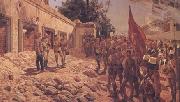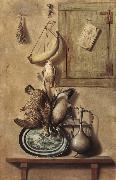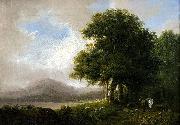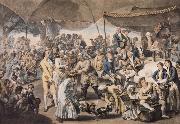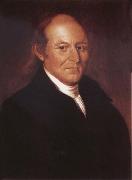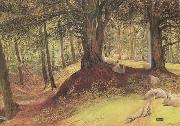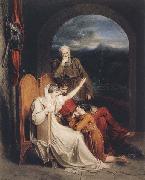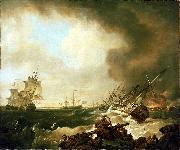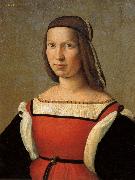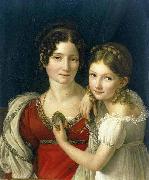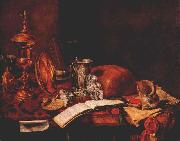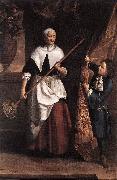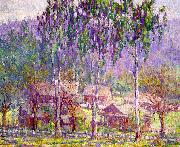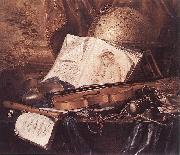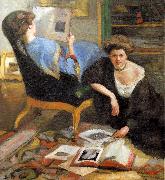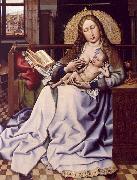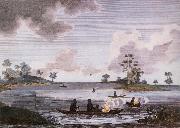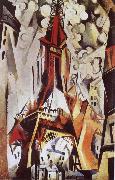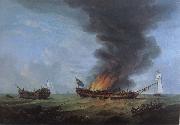|
|
|
|
|
|
|
|
|
|
|
|
|
|
|
|
|
|
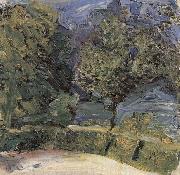 |
Richard Gerstl
|
|
(September 14, 1883 - November 4, 1908) was an Austrian painter and draughtsman known for his expressive psychologically insightful portraits, his lack of critical acclaim during his lifetime, and his affair with the wife of Arnold Schoenberg which led to his suicide.
Richard Gerstl was born in a prosperous civil family, Emil Gerstl, a Jewish merchant, and Maria Pfeiffer, non-Jewish woman. He visited the Viennese Piaristengymnasium (de) (Bundesgymnasium Wien 8 (de), Josefstadt), but he had to leave because of difficulties of discipline.
Early in his life, Gerstl decided to become an artist, much to the dismay of his father. After performing poorly in school and being forced to leave the famed Piaristengymnasium in Vienna as a result of "disciplinary difficulties," his financially stable parents provided him with private tutors. In 1898, at the age of fifteen, Gerstl was accepted the Academy of Fine Arts Vienna where he studied under the notoriously opinionated and difficult Christian Griepenkerl. Gerstl began to reject the style of the Vienna Secession and what he felt was pretentious art. This eventually prompted his vocal professor to proclaim, "The way you paint, I piss in the snow!"
Frustrated with the lack of acceptance of his non-secessionist painting style, Gerstl continued to paint without any formal guidance for two years. For the summers of 1900 and 1901, Gerstl studied under the guidance of Simon Hollesy in Nagybenya. Inspired by the more liberal leanings of Heinrich Lefler (de), Gerstl once again attempted formal education. Unfortunately, his refusal to participate in a procession in honor of Emperor Franz Joseph I of Austria further ostracized him and led to his departure. Gerstl felt that taking part in such an event was "unworthy of an artist." His final exit from Lefler's studio took place in 1908.
In 1904 and 1905, Gerstl shared a studio with his former academy classmate and friend, Viktor Hammer. Although Hammer had assisted in Gerstl's admittance to Lefler's tutelage and their relationship was friendly, it is difficult to determine how close the two men were as Gerstl did not associate with other artists. Regardless of their personal feelings, by 1906, Gerstl had acquired his own studio.
Although Gerstl did not associate with other artists, he did feel drawn to the musically inclined; he himself frequented concerts in Vienna. Around 1907, he began to associate with composers Arnold Schoenberg and Alexander von Zemlinsky, who lived in the same building at the time. Gerstl and Schoenberg developed a mutual admiration based upon their individual talents. Gerstl apparently instructed Schoenberg in art.
|
|
|
|
|
|
|
|
|
|
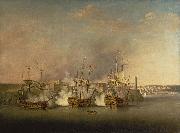 |
Richard Paton
|
|
was a British marine painter.
Paton spent his artistic career in London, where he is said to have been born, although no record of his birthplace or parentage is known. He is said to have grown up in poverty, and he is described as "self-taught". Some critics have discerned an influence of Samuel Scott's works, and also of Charles Brooking. Any such influence is hardly evident.
According to an account by Harry Parker, in "The Mariner's Mirror", March 1912, p 85, while Paton was begging "on Tower Hill, he attracted the attention of Admiral Sir Charles Knowles (died 1777), who happened to be passing that way, and who, taking a fancy to the boy, offered to take him to sea". He was assistant to the shipes painter on Knowles' ship, gaining knowledge in both painting and seamanship. In 1742, he started working at the Excise Office.
His first exhibition was in 1758 on the premises of the London-based Society of Artists, where he continued to exhibit up to 1770. The Royal Academy hosted his works between 1762 and 1780.
Paton's specialities were marine and naval paintings. He painted naval actions of wars ongoing at the time of painting such as the Seven Years War of 1756-1763 and later The American Revolutionary War, as well as earlier events such as the battles of the War of the Quadruple Alliance which took place when he was a baby. The paintings include many dramatic effects such as battles at night, the shooting of cannons and the effect of bombardments. There are, however, also less militant themes such as ships becalmed. His "sublime depiction of the sky" was considered especially noteworthy. Prints of his works, made among others by Pierre-Charles Canot, made them widely known.
|
|
|
|
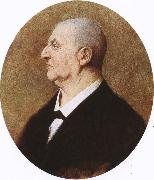 |
richard wagner
|
|
Born: 22 May 1813
Birthplace: Leipzig, Germany
Died: 13 February 1883
Best Known As: German composer of Der Ring des Nibelungen |
|
|
|
|
|
|
|
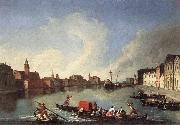 |
RICHTER, Johan
|
|
Swedish painter, Venetian school (b. 1665, Tukholma, d. 1745,
Venezia). |
|
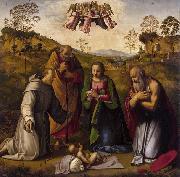 |
Ridolfo del Ghirlandaio
|
|
Ridolfo Ghirlandaio (or Ghirlandajo) (14 February 1483 - 6 June 1561) was an Italian painter of the Renaissance, active mainly in Florence, the son of Domenico Ghirlandaio.
He was born in Florence. Being less than eleven years old when his father died, Ridolfo was brought up by his uncle Davide Ghirlandaio, a painter of moderate talents. Vasari states that Ridolfo trained under Fra Bartolomeo.
His works between the dates 1504 and 1508 show a marked influence from Fra Bartolomeo and Raphael, with whom he was friends. From Rome in 1508, Raphael asked Ridolfo to join him; but the Florentine painter stayed. In Florence, he became one of the prominent painters of altarpieces, frescoes, and portraits.
He was prominent in the execution of vast scenic canvases for various public occasions, such as the wedding of Giuliano de' Medici, and the entry of Leo X into Florence in 1515. In his prime he was honest and conscientious as an artist; but from about 1527 he declined, having already accumulated a handsome property, more than sufficient for maintaining in affluence his large family of fifteen children, and his works became comparatively mannered and repetitive. His sons traded in France and in Ferrara; he himself took a part in commercial affairs, and began paying some attention to mosaic work, but it seems that, after completing one mosaic, the Annunciation over the door of the Annunziata Basilica, patience failed him for continuing such minute labours. In his old age Ridolfo was greatly disabled by gout. He appears to have been of a kindly, easy-going character, much regarded by his friends and patrons.
Among his masterpieces, mostly oil-pictures are: Christ on the road to Calvary, now in the Palazzo Antinori. An Annunciation in the Abbey of Montoliveto near Florence, Leonardesque in style. In 1504, he completed the Coronation of the Virgin. He painted a Nativity and a predella in the oratory of the Bigallo, Florence, five panels, representing the Nativity and other subjects. In 1514, on the ceiling of the chapel of St Bernard in the Palazzo Pubblico, Florence, a fresco of the Trinity, with heads of the twelve apostles and other accessories, and the Annunciation; also an Assumption of the Virgin, who bestows her girdle on St Thomas, in the choir loft of Prato cathedral. |
|
|
|
|
|
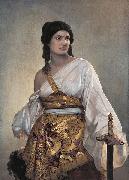 |
Riedel
|
|
August Riedel (1802 - 1883) |
|
|
|
|
|
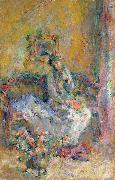 |
Rihard Jakopic
|
|
Rihard Jakopic
Rihard Jakopič (12 April 1869 - 21 April 1943) was a Slovenian painter. He was the leading Slovenian Impressionist painter and theoretician. Together with Matej Sternen, Matija Jama and Ivan Grohar, he is considered the pioneer of Slovenian impressionist painting. |
|
|
|
|
|
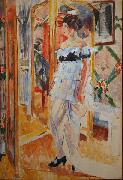 |
Rik Wouters
|
|
(21 August 1882, Mechelene11 July 1916, Amsterdam) was a Belgian fauvist painter and sculptor. Wouters was educated at the Academie Royale des Beaux-Arts in Brussels.
|
|
|
|
|
|
 |
Rinaldo Mantovano
|
|
Rinaldo Mantovano ( fl Mantua, c . 1527-39). Italian painter. According to Vasari, he was the best pupil of Giulio Romano. |
|
|
|
|
|
 |
Robert Alexander Hillingford
|
|
(1825-1904) was an English painter. He specialized in historical pictures, often battle scenes.
Contents
He was born in London on January 28, 1828, and studied in Desseldorf in 1841 for five years and before traveling to Munich, Rome, Florence and Naples, where he married and worked for several years, producing paintings of Italian life. One painting from this period entitled The Last Evening of the Carnival was exhibited at St. Petersburg in 1859. He returned to London in 1864, and first exhibited at the Royal Academy in 1866; it was at this time that he began to work on historical subjects, especially of the Napoleonic Wars. He was a regular exhibitor at the Royal Academy, British Institution and at other galleries. While he was attracted to costume pieces such as An incident in the early life of Louis XIV and During the wanderings of Charles Edward Stuart', he also included some contemporary military scenes including his 1901 RA painting South Africa, 1901 - The Dawn of Peace.
Wellington at Waterloo
Lord Hill invites the last remnants of the French Imperial Guard to surrenderThe original paintings often come up at auction, and, with a large amount of the collection dispersed in 1998, the original paintings are widely scattered.
|
|
|
|
|
|
|
|
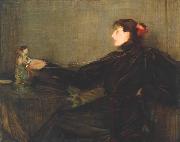 |
Robert Brough
|
|
(1872 - 21 January 1905) was a Scottish painter born in Invergordon, Ross and Cromarty.
He was educated in Aberdeen, and, whilst apprenticed for over six years as lithographer to Messrs Gibb & Co., attended the night classes at Gray's School of Art. He then entered the Royal Scottish Academy, and in the first year took the Stuart prize for figure painting, the Chalmers painting bursary, and the Maclame-Walters medal for composition.
After two years in Paris under J. P. Laurens and Benjamin-Constant at Julian's atelier, he settled in Aberdeen in 1894 as a portrait painter and political cartoonist. A portrait of Mr. W. D. Ross first drew attention to his talent in 1896, and in the following year he scored a marked success at the Royal Academy with his Fantaisie en Folie, which he bequeathed to the National Gallery of British Art (now the Tate gallery). Two of his paintings, Twixt Sun and Moon and Childhood of St. Anne of Brittany, were at the Venice municipal gallery. Brough's art was influenced by Henry Raeburn and by modern French training, but it strikes a very personal note.
Brough died from injuries received in a railway disaster in 1905.
|
|
|
|
|
|
|
|
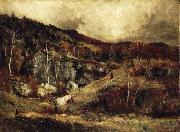 |
Robert Crannell Minor
|
|
(1839-1904), American artist, was born in New York City on 30 April 1839, and received his art training in Paris under Diaz, and in Antwerp under Joseph Van Luppen. His paintings are characteristic of the Barbizon school, and he was particularly happy in his sunset and twilight effects; but it was only within a few years of his death that he began to have a vogue among collectors. In 1897 he was elected a member of the National Academy of Design, New York. After 1900 he lived at Waterford, Connecticut, where he died on 4 August 1904. |
|
 |
Robert Dampier
|
|
(1799 - 1874) was a British artist and clergyman.
Dampier was born in 1799 at the village of Codford St Peter in Wiltshire, England He was baptised on the 20th of Dec. 1799 (LDS IGI record batch # C014402). He was one of 13 children of Codford St Peter's rector Reverend John Dampier (1763-1839) and his wife Jane. In 1819 he went to Rio de Janeiro in Brazil as a clerk. In 1825, he was picked up in Rio to be the expedition artist on the English ship HMS Blonde under the command of Captain George Anson Byron. The ship was returning the bodies of King Kamehameha II and Queen Kamemalu to the Hawaiian islands (known by the British as "Sandwich Islands"), after both died from measles during a visit to England. Robert Dampier spent 11 weeks in Hawaii painting portraits in oil paint and making pencil drawings of landscapes.
After returning to England, he studied law at Cambridge University and then was ordained in the Church of England. He married Sophia Francis Roberts in 1828. In 1837 he became rector of Langton Matravers church. Circa 1843 they had a daughter Juliana Sophia, His wife Sophia died in 1864, and he married again in 1872. He had a daughter Frederika from the second marriage. Although employed a rector, he continued to sketch until his death in 1874.
Major works by Robert Dampier are held by the Honolulu Academy of Arts and Washington Place, also in Honolulu, Hawaii.
|
|
|
|
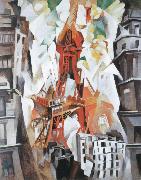 |
robert delaunay
|
|
French painter, printmaker and writer. Taking Cubism as one of his points of departure, he first developed a vocabulary of colour planes only distantly dependent on observed motifs, and by the 1930s he had arrived at a purely self-sufficient language of geometric forms. He remained active as a theoretician until the end of his life, leaving a legacy of influential writings on the development of abstract art.
|
|
|
|
|
|
|
|
|







